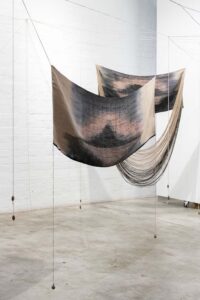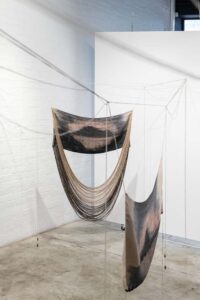IN THE GALLERY: Grand-Mother Island Project – Chapter 1: Nautical Map

Grand-Mother Island Project - Chapter 1: Nautical Map
THIS IS NO FANTASY, 2024
Installation View
Photo: Simon Strong

Grand-Mother Island Project - Chapter 1: Nautical Map
THIS IS NO FANTASY, 2024
Installation View
Photo: Simon Strong

Grand-Mother Island Project - Chapter 1: Nautical Map
THIS IS NO FANTASY, 2024
Installation View
Photo: Simon Strong

Grand-Mother Island Project - Chapter 1: Nautical Map
THIS IS NO FANTASY, 2024
Installation View
Photo: Simon Strong

Grand-Mother Island Project - Chapter 1: Nautical Map
THIS IS NO FANTASY, 2024
Installation View
Photo: Simon Strong

Grand-Mother Island Project - Chapter 1: Nautical Map
THIS IS NO FANTASY, 2024
Installation View
Photo: Simon Strong

Grand-Mother Island Project - Chapter 1: Nautical Map
THIS IS NO FANTASY, 2024
Installation View
Photo: Simon Strong

Grand-Mother Island Project - Chapter 1: Nautical Map
THIS IS NO FANTASY, 2024
Installation View
Photo: Simon Strong

Grand-Mother Island Project - Chapter 1: Nautical Map
THIS IS NO FANTASY, 2024
Installation View
Photo: Simon Strong

Grand-Mother Island Project - Chapter 1: Nautical Map
THIS IS NO FANTASY, 2024
Installation View
Photo: Simon Strong

Grand-Mother Island Project - Chapter 1: Nautical Map
THIS IS NO FANTASY, 2024
Installation View
Photo: Simon Strong

Grand-Mother Island Project - Chapter 1: Nautical Map
THIS IS NO FANTASY, 2024
Installation View
Photo: Simon Strong

Grand-Mother Island Project - Chapter 1: Nautical Map
THIS IS NO FANTASY, 2024
Installation View
Photo: Simon Strong

Grand-Mother Island Project - Chapter 1: Nautical Map
THIS IS NO FANTASY, 2024
Installation View
Photo: Simon Strong

Grand-Mother Island Project - Chapter 1: Nautical Map
THIS IS NO FANTASY, 2024
Installation View
Photo: Simon Strong

Grand-Mother Island Project - Chapter 1: Nautical Map
THIS IS NO FANTASY, 2024
Installation View
Photo: Simon Strong

Grand-Mother Island Project - Chapter 1: Nautical Map
THIS IS NO FANTASY, 2024
Installation View
Photo: Simon Strong

Grand-Mother Island Project - Chapter 1: Nautical Map
THIS IS NO FANTASY, 2024
Installation View
Photo: Simon Strong
VIDEOS
Haji Oh
17 Jul - 17 Aug 2024
We’re excited to present Haji Oh’s first exhibition in the gallery, and before showing at Paris Photo Art Fair in November.
Since 2017 Haji Oh has engaged in an extended series of creation and installation work titled ‘Grand-Mother Island Project’, in which she traces the trajectories of people who have crossed the Pacific Ocean between Japan, Korea, Nauru, Torres Strait, Australia, and places in-between.
‘Grand-Mother Island Project: Chapter 1- Nautical Map’ is the first part of this project. Comprising three textile elements – ‘Textile as Map j.i (Jeju Island, Korea)’, ‘Textile as Map t.i (Thursday Island, Queensland, Australia)’ and ‘Textile as Map Mt.k (Mount Kiera, NSW, Australia)’, the work traces the trajectories of island and ocean crossings between Japan, Korea, Torres Strait, and Australia. It focuses on the individual narratives interwoven with global histories to create new communities.
The ‘Grand-Mother Island’ constitutes an imaginary space that inherits and generates untold stories. The ‘islands’ are metaphors for political and personal relationships, as well as for spaces to explore both private and shared histories beyond the nation-state. Political Scientist Benedict Anderson considers the nation to be an “imagined political community where belief in a shared history strengthens the sense of national belonging”. The ‘Grand-Mother Island Project’ conceives spaces between nations as spaces of movement that expand our personal horizons. Using the metaphor and universal experience of ‘the grandmother’, the project aims to bring to life stories of a connected past, opening us to others.
Oh’s meticulous and labour-intensive process of creating the textile works underscores the narrative. The shape of the islands emerge through the dying and bleaching of the warp thread, which forms part of the preparation for the weaving process. In four-selvaged cloth (a finished textile that has no cut edges or hems), the spiral of the warp thread is intersected by the weft thread, symbolizing the continuity of memory and time and the convergence of the past with the present. The resulting woven works are an embodiment of space, time, and memory.

